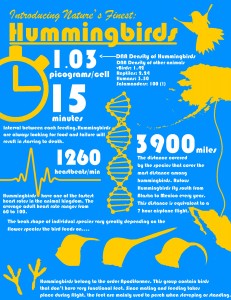by Randolf Lee and Nick Mirza
 What are some of the things that come to mind upon hearing the word “fitness?” The immediate reaction is to think of how fitness applies to humans – strength, speed, and agility are commonly associated with fitness. These traits constitute a rather narrow definition of fitness; in the context of biology, fitness takes on a much broader definition to include any traits that increase reproductive success. In practice, fitness appears in an incredibly wide variety of forms, many of which defy the common conceptions of what it means to be fit.
What are some of the things that come to mind upon hearing the word “fitness?” The immediate reaction is to think of how fitness applies to humans – strength, speed, and agility are commonly associated with fitness. These traits constitute a rather narrow definition of fitness; in the context of biology, fitness takes on a much broader definition to include any traits that increase reproductive success. In practice, fitness appears in an incredibly wide variety of forms, many of which defy the common conceptions of what it means to be fit.
Hummingbirds are an excellent example of organisms whose evolution contradicts conventional notions of what it means to be “fit”. The blazing fast speeds at which hummingbirds flap their wings give them remarkable flying abilities. This comes at a high cost: hummingbirds have a huge metabolic demand relative to their size. In other words, a huge amount of energy is needed to sustain hummingbird flight. It might seem that the high metabolic demand caused by hummingbirds’ flight mechanics would favor the evolution of slower wing speeds. This does not appear to be the case. Instead, one of the ways that hummingbirds compensate for the high metabolic demand of their wing flapping is by reducing metabolic demand in an entirely different realm: DNA. Current research suggests that natural selection has favored smaller genome sizes in hummingbirds (and other avian species). Smaller genomes require less energy during replication and maintenance, meaning precious resources can be used by flight muscles. This budgeting of energy consumption allows hummingbirds to maintain their stunning flight abilities without sacrificing other physical abilities or raising their already high caloric demand. The reduction of genome size is probably not among the first things that come to mind when thinking about evolutionary adaptation and fitness. One commonly held belief regarding evolution is that complexity and fitness go hand-in-hand; it would therefore be assumed that large and highly complex genomes would result in higher fitness. Hummingbirds demonstrate that this is not the case, and that fitness is manifested in a variety of ways.
Hummingbird evolution is also an excellent example of speciation caused by isolation of populations from one another. There are about 350 identified hummingbird species, all of whom live in the Americas. A considerable number of these species are found in the Andes Mountains. Contemporary research suggests that as parts of the Andes gradually rose in elevation (due to tectonic shifting), hummingbird populations were forcibly separated, which eventually led to speciation. More specifically, the genus Adelomyia split into several species due to uplift in the northern reaches of the Andes.
For more information see:
Chaves, J. A., Weir, J. T., & Smith, T. B. (2011). Diversification in Adelomyia hummingbirds follows Andean uplift. Molecular Ecology, 20,21.
Chaves, J. A., & Smith, T. B. (2011). Evolutionary patterns of diversification in the Andean hummingbird genus Adelomyia. Molecular Phylogenetics and Evolution, 60,2.
Gonzlez, C., Ornelas, J. F., & Gutierrez-Rodriguez, C. (2011). Selection and geographic isolation influence hummingbird speciation: Genetic, acoustic and morphological divergence in the wedge-tailed sabrewing (Campylopterus curvipennis). BMC Evolutionary Biology, 11, 1.
Kirchman, J. J., Witt, C. C., McGuire, J. A., & Graves, G. R. (2010). DNA from a 100-year-old holotype confirms the validity of a potentially extinct hummingbird species. Biology Letters, 6, 1, 112-5.
Parra, J., McGuire, J. A., & Graham, C. (2010). Incorporating clade identity in analyses of phylogenetic community structure: an example with hummingbirds. The American Naturalist, 176, 5.
Wright, N. A., Gregory, T. R., & Witt, C. C. (2014). Metabolic ‘engines’ of flight drive genome size reduction in birds. Proceedings of the Royal Society of Biological Sciences, 281.
